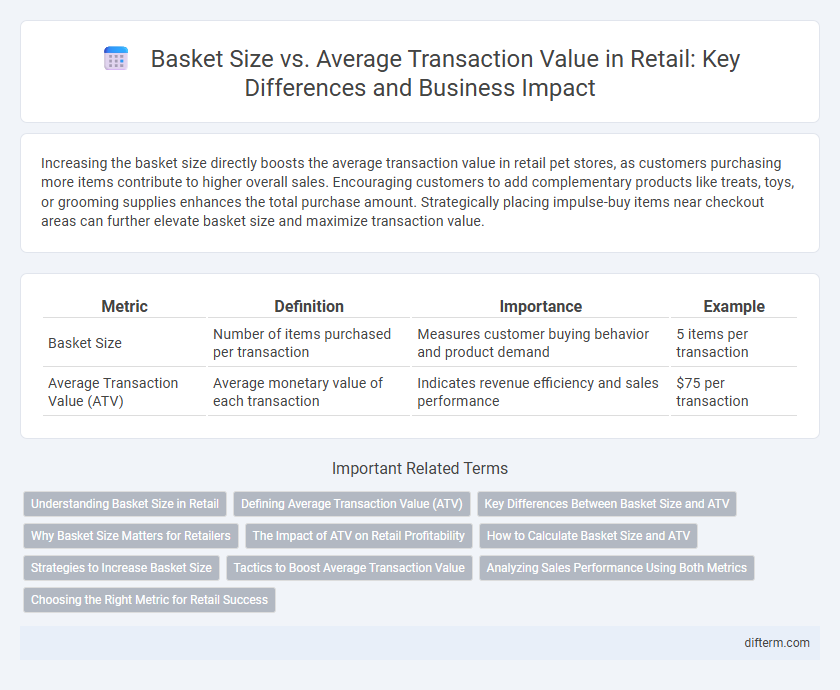Increasing the basket size directly boosts the average transaction value in retail pet stores, as customers purchasing more items contribute to higher overall sales. Encouraging customers to add complementary products like treats, toys, or grooming supplies enhances the total purchase amount. Strategically placing impulse-buy items near checkout areas can further elevate basket size and maximize transaction value.
Table of Comparison
| Metric | Definition | Importance | Example |
|---|---|---|---|
| Basket Size | Number of items purchased per transaction | Measures customer buying behavior and product demand | 5 items per transaction |
| Average Transaction Value (ATV) | Average monetary value of each transaction | Indicates revenue efficiency and sales performance | $75 per transaction |
Understanding Basket Size in Retail
Basket size in retail refers to the total number of items a customer purchases in a single transaction, while average transaction value (ATV) measures the total monetary amount spent per transaction. Analyzing basket size helps retailers identify purchasing patterns, optimize inventory management, and tailor marketing strategies to increase both item count and spend. A larger basket size often correlates with higher ATV, driving overall revenue growth and enhancing customer satisfaction.
Defining Average Transaction Value (ATV)
Average Transaction Value (ATV) measures the average dollar amount spent per customer transaction, calculated by dividing total sales revenue by the number of transactions. Basket size refers to the quantity of individual items purchased in a single transaction, which directly influences ATV by increasing the total spend. Retailers analyze ATV to optimize pricing strategies and promotions, aiming to increase basket size and overall revenue.
Key Differences Between Basket Size and ATV
Basket size refers to the number of items a customer purchases in a single transaction, while Average Transaction Value (ATV) measures the total monetary amount spent per transaction. Key differences lie in basket size emphasizing quantity, whereas ATV focuses on revenue generated, influencing inventory management and pricing strategies. Retailers analyze both metrics to optimize sales performance by balancing product mix and pricing to maximize overall profitability.
Why Basket Size Matters for Retailers
Basket size directly influences average transaction value, reflecting the total number of items purchased per sale, which is crucial for maximizing revenue and profit margins in retail. Larger basket sizes indicate higher consumer engagement and increased cross-selling opportunities that enhance overall store performance. Retailers track basket size to tailor marketing strategies, optimize inventory management, and elevate customer lifetime value through personalized promotions and product recommendations.
The Impact of ATV on Retail Profitability
Average Transaction Value (ATV) directly influences retail profitability by increasing the revenue generated per customer visit, making each sale more valuable. Larger basket sizes often correlate with higher ATV, enhancing margins and reducing fixed costs per transaction through efficient inventory turnover. Retailers who effectively boost ATV using upselling, cross-selling, and promotions can significantly improve profit margins and overall financial performance.
How to Calculate Basket Size and ATV
Basket size is calculated by dividing the total number of items sold by the number of transactions during a specific period, reflecting customer purchasing behavior. Average Transaction Value (ATV) measures the average revenue per transaction, calculated by dividing total sales revenue by the number of transactions. Both metrics provide critical insights for retail businesses to optimize sales strategies and improve revenue management.
Strategies to Increase Basket Size
Increasing basket size directly boosts average transaction value, driving higher revenue per customer visit. Implementing strategies such as personalized product recommendations, cross-selling complementary items, and offering tiered discounts encourages customers to add more products to their basket. Retailers leveraging data analytics to tailor promotions and optimize product placement enhance shopper engagement and maximize basket size growth.
Tactics to Boost Average Transaction Value
Increasing basket size directly enhances Average Transaction Value (ATV) by encouraging customers to purchase more items per visit. Implementing tactics such as product bundling, targeted upselling, and personalized recommendations leverages shopper behavior to maximize spend. Utilizing loyalty programs and limited-time promotions effectively incentivizes larger purchases, driving revenue growth in retail environments.
Analyzing Sales Performance Using Both Metrics
Basket size and average transaction value (ATV) serve as crucial metrics for analyzing retail sales performance, providing distinct yet complementary insights into consumer purchasing behavior. Basket size measures the number of items per transaction, highlighting product mix and customer engagement, while ATV focuses on the total revenue generated per transaction, reflecting pricing strategies and promotional effectiveness. Evaluating both metrics in tandem enables retailers to optimize inventory management, tailor marketing efforts, and enhance overall profitability by balancing quantity sold with the revenue per sale.
Choosing the Right Metric for Retail Success
Basket size measures the total number of items purchased per transaction, providing insight into customer buying behavior and product affinity. Average transaction value (ATV) reflects the total revenue generated per purchase, highlighting spending patterns and pricing effectiveness. Retailers aiming for growth must carefully select metrics aligned with strategic goals--basket size drives volume-focused strategies, while ATV emphasizes revenue optimization and profitability.
basket size vs average transaction value Infographic

 difterm.com
difterm.com